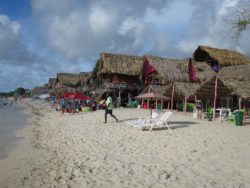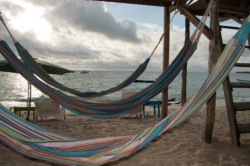Playa Blanca
Envision paradise. White sand, palm trees, thatched roof huts, and hammocks. Nothing to do but sit back with a book, sip a beer, and occasionally hop in the water when the beating sun becomes too much. You’re picturing Playa Blanca, a beach tucked away 20 miles from Cartagena, the paradise that other paradises are based on.
Playa Blanca puts on no airs, which I think is its main strength. It has thatched roofs not to achieve some idyllic aesthetic a la Margaritaville, but because that’s simply the most readily available roofing material. The buildings are made with a combination of chopped down palm trees and planks of wood reclaimed from shipping pallets. The restaurants consist of a few plastic tables and chairs, and the kitchens are nothing more than a cookfire behind the building. There are generally so few customers that you often have to track down the owner, who might be napping in a hammock or having a drink with some friends, so that you can put in your order. Almost all businesses on the beach are family run, so usually the owner’s wife, daughter, or mother will be the one cooking your meal.
Accommodation is cheap. You have a choice between a hammock or a cabaña, which is nothing more than a single room with a bed. We opted for the hammocks, as the breeze at night helps stave off some of the heat, making it easier to sleep. They cost a whopping 15,000 pesos, or $5, per person per night. Drifting off to the sway of the hammock, the salty sea breeze, and the sound of the lapping waves just 15 feet away was definitely a nice way to end each day.
On one night, we were invited by a group of Argentinian hippies to join them for some live music. It turned out to be just an impromptu music circle, with a few instruments passed from hand to hand as they recalled Argentinian songs, both traditional and modern. People filtered in and out of the group, and the family that owned the restaurant nearby sang along appreciatively as their chubby baby clapped with the music.
It turned out that the group of musicians ran the local dive shop, which offers scuba, snorkeling, and boat tours to various points of interest in the area. The most highly recommended activity was the “plankton tour”, which at first glance didn’t appear to be all that interesting. How exciting could plankton, of all things, be? With repeated prompting, and even unsolicited recommendations from the locals, we decided to try the tour, and it was undoubtedly the highlight of our visit to the beach.
It turns out that there is a particular strain of bioluminescent plankton that thrives in the warm Caribbean waters in that area. After the sun had set, five of us clambered into a small boat with three guides and headed off into the darkness. About 20 wet minutes later, we arrived at a seemingly inauspicious patch of water, where the guide gave us a quick lecture about the plankton itself and its impact on the ecosystem; apparently phytoplankton produce up to 80% of the Earth’s oxygen. After the spiel we were encouraged to run our hands through the water. I did so, a bit unsure of what to expect.
The trail of water glowed a brilliant blue-green color as my hand passed through. In the darkness, it was something almost magical. We were encouraged to hop out of the boat and go swimming through the water, which created a glowing outline of each person’s body as they moved around. Waving my arms, I felt almost like the Human Torch, trailing a burst of light around my hands. Occasionally someone would dive under the water and you could see a muted glow move around beneath the surface as they swam. Eventually, we reluctantly got back in the boat and sped off, the boat’s wake glowing behind us. The whole experience cost us each 35,000 pesos, or around $12.

Unfortunately not my photo, as my camera isn’t good enough to capture it, but the glow looked very similar.
There are some downsides to living in paradise. The first night, it rained. What would normally be a mild inconvenience was exacerbated by the fact that we were sleeping outside, so we were unfortunately cold and wet the whole night, leaving us miserable and tired the next morning. Luckily, there was plenty of time for naps later in the day. There is no electricity, except for the four hours or so each night that the generators are run. This means the drinks are kept in styrofoam coolers rather than fridges, there are no fans to create a breeze, and any dreams of air conditioning will remain dreams. There’s also no true plumbing; you’re provided with a large bucket of water to dump in the toilet to simulate a flush, and the “shower” is a small room with a drain and yet another bucket of water to rinse yourself off with. In some ways, I think having true infrastructure would almost taint the unspoiled nature of the beach, although I wouldn’t have minded slightly colder beers…
Some Tips
- There are numerous shuttles that run daily to and from Cartagena. Most of the shuttles leave between 8-10am from Cartagena and return around 4-5pm, but you do not need to take the shuttle back on the same day you arrive. It should cost around 50,000 pesos ($17) for a round trip.
- Bring cash. Let me repeat. Bring all the cash you will need. We naively assumed that there would be ATMs on the beach. After all, it’s a fairly popular tourist attraction. This is not the case. Unfortunately, we had to dish out an extortionately high 60,000 pesos to get a ride to the nearest town so that we could take enough cash out to last us the four days we were there. Take money out in Cartagena before stepping foot on the bus.
- External batteries are key. As mentioned, there is only electricity for a few hours each night, and the generators only provide so much, so they are reluctant to let you charge up all your devices while trying to illuminate their bars and restaurants. Having a portable power source or three lets you top off your devices, although you should try to stick to just the essentials.
- Learn to say “no, gracias”. Vendors will wander up and down the beach offering various goods and services, and they can be very persistent. Do not take anything they offer towards you unless you intend to pay for it. That said, if you ever wanted a great massage on the beach, it might be worth spending the $10.
- Do the plankton tour. Worth every penny, and there are only a few places in the world you can see something like it.
Playa Blanca is the “simple life” as many people picture it. The people have few cares other than tending their businesses, providing for their families, and enjoying time (and drinks) with friends. The beach is so small that everyone knows everyone, so the vendors will often stop to chat with the bar owners, and the people are open and friendly, even while trying to sell you something. At one point I was in a conversation with a local, who was asking with curiosity about where we were from. I talked a bit about LA and Ohio. The man remarked that those places sounded nice, then looked around and said “But what we have here is perfect. What else could I want?” Honestly, I’m not really sure.











